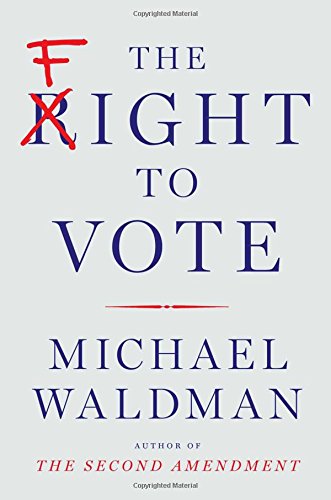

| THE FIGHT TO VOTE Michael Waldman New York: Simon & Schuster, 2016 |
Rating: 5.0 High |
|||
| ISBN-13: 978-1-5011-1648-3 | ||||
| ISBN-10: 1-5011-1648-7 | 368pp. | HC | $28.00 | |
America's political history has been a tumultuous one, rife with disputes over who should be able to vote, as well as how and where. The overall trend has been toward greater inclusiveness, as first landless white men got the vote when at the nation's beginning it was restricted to male property owners. Then, after the Civil War, the franchise was — against opposition — extended to black men. At the turn of the twentieth century, women begain to strike for suffrage, and they got the vote in 1920.1
At the same time, privileged groups have always fought to restrict the people they did not like from participation in elections. Their efforts are made easier by the fact that the mechanics of elections, such as how many voting machines are made available in a given district, are decided at the state and/or local level.
But federal laws have also played a major part in either blocking or facilitating these restrictions.
...on June 25, 2013, the U.S. Supreme Court struck down the key provision of the Voting Rights Act, the landmark civil rights law. Just two hours after the announcement, the State of Texas implemented new rules. Texans would now have to show a state-issued photo ID to vote. The law was mischievously crafted by the state's Republican lawmakers; voters could present a concealed-carry gun permit, for example, but not a University of Texas student card. Instantly hundreds of thousands of citizens, disproportionately African American or Hispanic, many of whom had cast ballots for decades, were ineligible to vote. – Page ix |
The situation we face today is particularly perilous. The Supreme Court has neutered the Voting Rights Act by striking down its Section 5, and approved unlimited, undisclosed donations by private individuals or corporations to campaigns. Some states have taken advantage of the freedom from the Voting Rights Act, imposing burdensome ID requirements which effectively impede poor and elderly people from being able to vote. Wealthy Republicans, meanwhile, have used their money to distort the political process throughout the nation, assuring the election of candidates who favor policies that benefit them: lower taxes and fewer regulations on their businesses. Then there is the artful contruction of districts to favor one party — a long-standing practice known as gerrymandering.2
Michael Waldman, president of the Brennan Center for Justice at NYU Law School, describes in detail how this all came about. He covers the vagaries of American politics and jurisprudence on matters of voting from the nation's inception to the present. It is a tangled tale, but well worth reading. I found Part IV especially relevant, since it deals with our modern era. There is plenty here to stir the outrage of those who want their choices at the polls to matter, and to inspire them to get out and vote this November, when it matters a great deal.
This is a rare moment. The public deeply cares about inequality and its challenge to American ideals and identity. We care, too, about the unequal ways in which political power is deployed. Citizens see the connection. They know they will not get a government that works better, or that addresses long delayed challenges, unless the system is made to work for them. They see the direct line between a broken democracy, a broken government, and a diminished future. Yet still millions do not vote. Activism abounds, often tremendously creative. But hashtag campaigns and the profusion of creative new ways to press for change will fall short if they do not translate, soon, into real political activity expressed at the ballot box. When we fail to vote, we leave political power on the table. – Page 263 |
Waldman writes well, and clearly explains the complicated issues. His book contains extensive endnotes and a good index. There is as well a discussion of sources that he found particularly useful. This is without doubt both a "must read" and a keeper.

 To contact Chris Winter, send email to this address.
To contact Chris Winter, send email to this address.